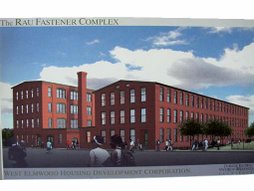As published in the Providence Phoenix on 04/29/2005 written by Robin Amer.
Rau Fastener offers a new model for affordable lofts
By Robin AmerProvidence Phoenix April 29, 2005
Starting in December 2005, units will be available in Westfield Lofts, formerly the Rau Fastener mill complex, on Dexter Street near the Cranston Street Armory. The West Elmwood Housing Development Corporation is the force behind the $15 million rehab project, remaking the 1890 mill complex into 69 one- and two-bedroom lofts. Upon completion, Westfield Lofts will be the city’s only CDC-sponsored mill redevelopment effort, offering units of low-income housing, and moderate-income units far cheaper than other loft projects in town.
The project is almost 10 years in the making. Sharon Conard-Wells, West Elmwood’s executive director, says the seeds were planted in 1997, when neighborhood residents asked her, "What are you going to do with this thing in the middle of the neighborhood?" Her response was "We don’t do mills." But neighbors felt so strongly that they presented petitions and letters to West Elmwood’s board, in hopes it would tackle the four-story, 109,000-square-foot building.
Westfield Lofts will consist of 22 affordable one- and two-bedroom rental units, starting at a monthly rent of $498, a price bounded by the tax credits used to partially finance the project. Prospective tenants must meet federal low-income guidelines. There will also be 47 one- and two-bedroom units renting at between $850 and $1300 a month — about half the price of similar lofts being developed downtown and in other mill redevelopment projects.
Conard-Wells says the mixed-income rent structure will benefit neighborhood families who make too much to qualify for low-income housing, but need help on their way to home ownership. The affordable units will be mixed in with the other units, rather than clustered in one section of the building.
The mill rehab is the first phase of the CDC’s bigger plans for the area. An adjacent mill building will eventually be converted into office space. A large vacant lot behind the property will be turned into 24 townhouses, and lots across Dexter Street will be redeveloped into multi-family homes. Conard-Wells believes the efforts will improve people’s perception of the neighborhood. "I’m one of the first to say the neighborhood isn’t 100 percent of what it should be," she says. "But I’m also one of the first to say it’s not nearly as bad as the perception. This project will help close the gap between perception and reality." The project could also have a major impact on property values, Conard-Wells says, and on the investment current residents are willing to make in their own homes.
Asked how West Elmwood managed to finance such a project, she laughs, "I beg. I have no pride. I’ll ask for money all the time." In reality, the organization pieced together multiple sources, including federal funds, low-income tax credits, US Environmental Protection Agency bucks for environmental remediation, a bridge loan from Bank of America, and help from such national groups as the Local Initiatives Support Corporation (LISC) and Neighborworks America. Conard-Wells says project architects Durkee Brown Viveiros & Werenfels, which is receiving a percentage of the total construction costs, subordinated an increase in its fee when construction costs increased.
Low- and moderate-income artists are among those being targeted as residents, in hopes that their presence will accentuate the neighborhood’s positive characteristics. The units will be offered on a first-come, first-served basis, provided prospective renters’ credit checks out.
"This is a really cool project," says Laura Mullen of Rhode Island Citizens for the Arts’ Sustainable Artist Space Initiative. "I’m so impressed by Sharon and what they’ve been able to accomplish and how much thought they’ve been able to put into it."
Mullen says the Rau Fastener project is proof that for all the cost and difficulty associated with turning old mill buildings into new housing, it is possible to create affordable spaces. "Sharon’s previous experience in the affordable housing world gave her all the skills to make this happen," Mullen says. "Because she already knew the nonprofit affordable housing world… she also had access to funding and grants not available to for-profit developers. That’s part of the beauty of nonprofit developing."



No comments:
Post a Comment